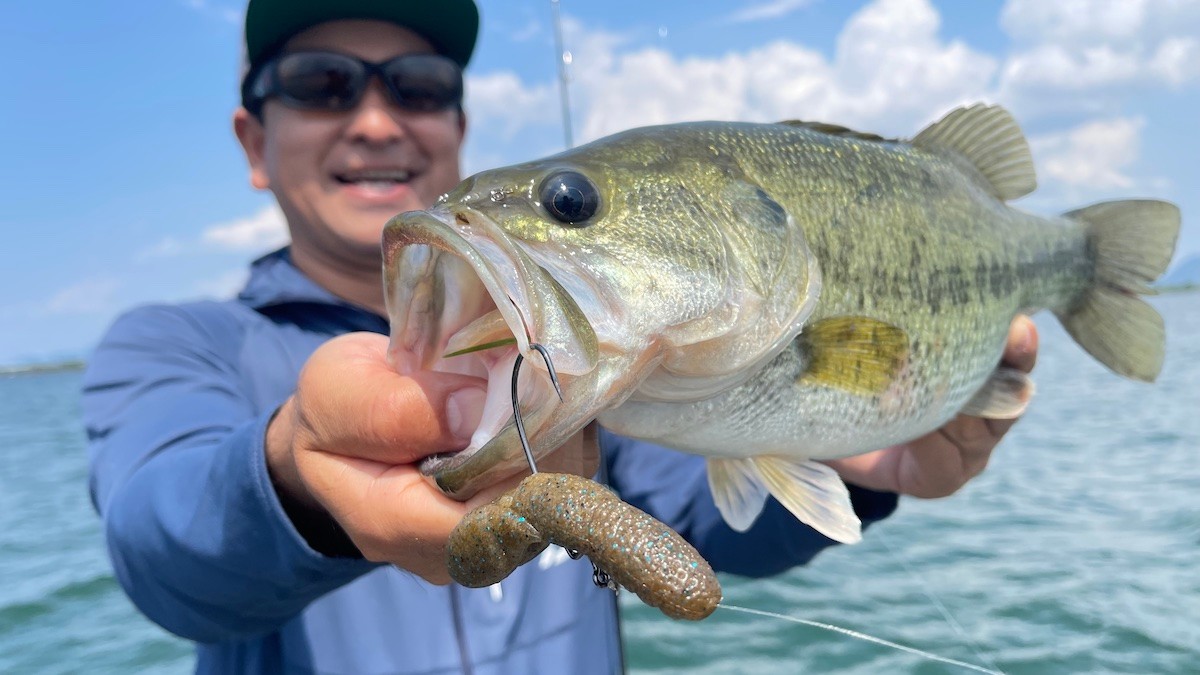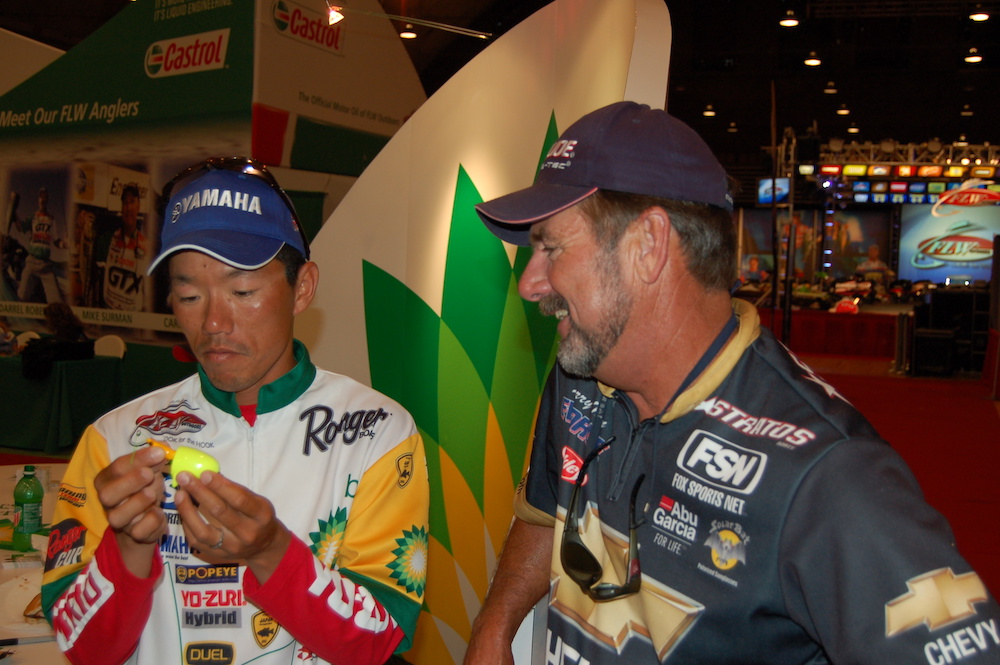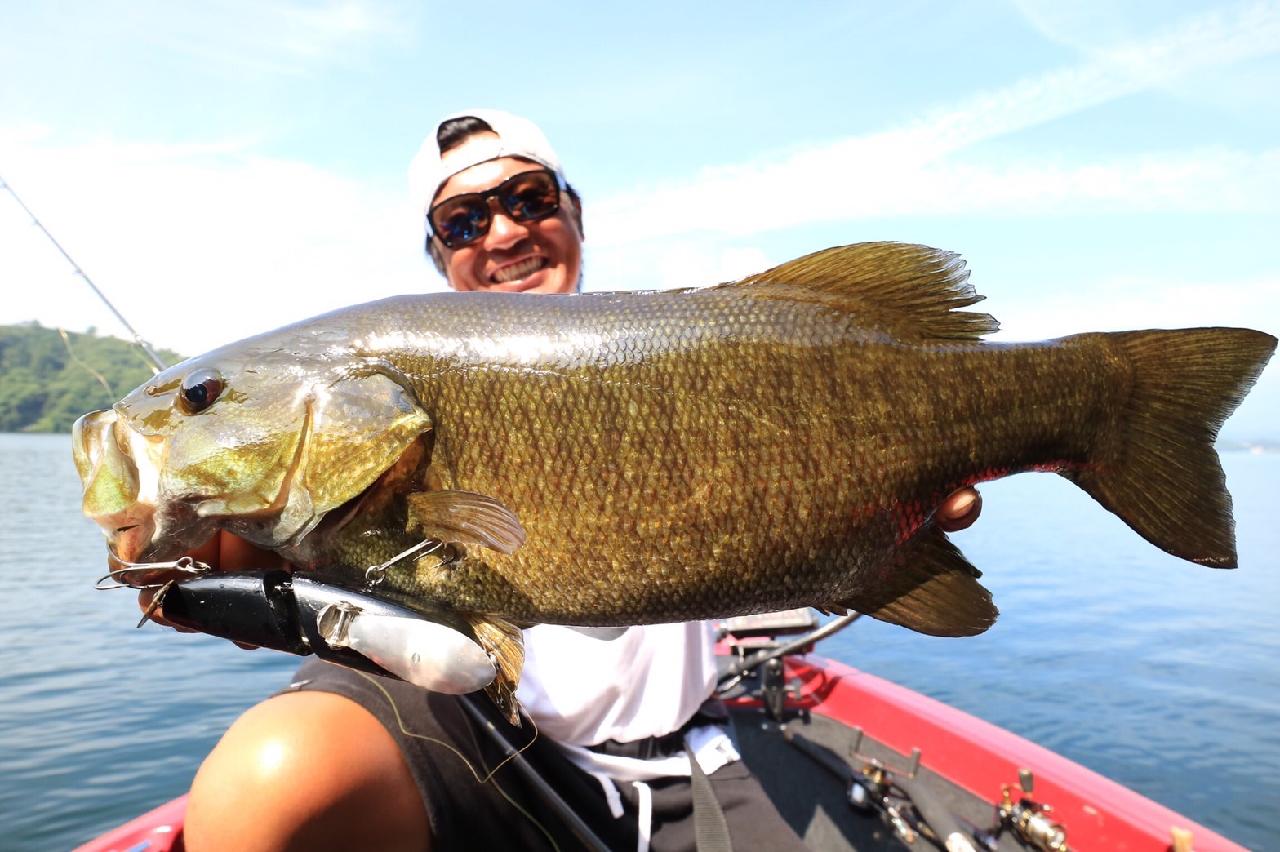
On my 2007 trip to Tokyo, I spent $36 at a tackle shop on an artificial shrimp in a cup. This was not a random purchase. My friend Matt Paino, president of Optimum Swimbaits, who had gone to college in Japan and subsequently imported several Japanese tackle brands to the U.S., took me on to the Yokohama tackle shop, and then on an epic tour of Tokyo’s tackle shops. During the latter, he made some subtle nods at particular brands or products, but it was only when we got to the shrimp-in-a-cup that he became animated.
Technically, this gizmo is called the Tubo Rig. As I implied above, it includes a smaller-than-a-shot glass with supports that allow it to rest on its side. You thread your line through a hole in the bottom of the cup and then tie it to a small floating shrimp (with or without a hook). Then, when you see a bass on a bed or guarding something, you pitch the whole shebang in there, let it settle, and then release a bit of line. The shrimp will float up and out of the cup.
A curious bass, noticing the shrimp, will come over to investigate. Your first inclination may be to let them have it, but the better tactic is to pull the shrimp back into the cup. The bass will become curious, so then you let out line again. Lather, rinse, repeat.
Eventually, the fish should become so fired up that if you have a hook on the shrimp you can let ‘em have it and attempt to reel ‘em into the boat. Unfortunately, that heavy cup enables a thrashing fish to throw the hook, so what most Tubo advocates do is pull the whole deal back into the boat and employ the old bait-and-switch with a single-hooked soft plastic unencumbered by something in front of it.
The Tubo Rig is just the tip of the iceberg of my very dangerous–in terms of my wallet and my marriage–addiction to Japanese tackle. I certainly have plenty of American-made gear (as well as items I’ve picked up in Brazil and elsewhere), but historically it’s been Japanese gear that has piqued my interest. As the shrimp in a cup showed, there’s just a level of constant innovation and precision that makes me more confident on the water—as well as some genuinely weird and wacky ideas on how to catch fish.

Japanese Influences I recall about 20 years ago when I first heard about the Lucky Craft Pointer, a Japanese jerkbait that had come to the U.S. through the California market and was allowing certain in-the-know tournament anglers to dominate some Western events. It suspended more easily and more consistently than more rudimentary traditional jerkbaits. It came with more realistic paint jobs and had better hardware, including treble hooks that’d stab you if you just looked at them funny.
It also came with a $15 price tag at a time when the competition charged three to five bucks a pop. It seemed heretical to throw that thing into the lion’s den on a budget, but when anglers learned that it could outfish its predecessors—usually when they got their asses handed to them by their faster-moving friends—it was a no-brainer.
That price tag seems almost quaint today. Fanatics pay more than that in shipping just to get products over here from Asia on an expedited basis. Certain swimbaits cost several hundred to over a thousand dollars. Plenty of obsessives will buy jerkbaits that retail for twice what that Lucky Craft did and then reach back into their wallet to get it further customized with a special paint job. And there’s no shortage of customers, especially in these times of supply chain issues. Munenori Kajiwara of Illinois, the owner of Japan Import Tackle, told me that the easiest things to sell these days are thousand-dollar rods and reels–they’re purchased before he can get them off the shipping pallet. He said he almost feels badly because most of the buyers are anglers of comparatively modest means.
This fetish for hyper-refined Japanese tackle–in my house and the houses of other obsessives–has been bolstered primarily by two things. The first, of course, is the Internet. Today not only can you easily learn about the hottest lures across the pond, but you can watch how they operate on YouTube and purchase them via an online auction site or retailer that same day. The second influence is the rise of the Japanese bass pros. There have always been some on tour dating back to the 1980s, but as their success has grown–often using novel techniques that can’t be easily hidden in the age of live-streamed action. American anglers have taken note.
The Finesse Connection Because many of Japan’s bass fisheries are relatively small and highly pressured, the country’s bass fishermen have proven particularly innovative when it comes to finesse techniques. Dropshotting was popularized there and received some initial resistance when it was first brought to the States. I remember one old-time gruff Texan power-fishing pro who called it “the upside-down catfish rig.” Then he got his ass kicked with some 6-pound fluorocarbon and decided he’d better learn.
Subsequently, iterations like the Tokyo Rig—essentially a dropshot with a downward-facing wire instead of the lower leader—came along. Neko Rigging, a variation of the Wacky Rig, has become exceptionally popular, too. While in many cases it was the Japanese pros who brought these techniques here, the ones who benefitted the most may have been U.S. pros who weren’t afraid to use a light line. It’s no coincidence that the late Aaron Martens originally hailed from California, the entryway for Japanese tackle. He was never afraid to use a 5- or 7-pound line in big bass country.
Free Rigs and Hover Strolling The early resistance gave way to a welcoming committee. Pro anglers who previously may have been disinclined to befriend a newcomer, particularly one who didn’t speak their language fluently, became one-man welcoming committees. Weekend anglers and writers like me sought out the latest and greatest tackle from overseas and tried to understand how to use it to gain an edge.
While I’d still rather flip braided line in heavy grass, my spinning rod contingent has grown substantially in recent years because the light stuff makes a difference under the toughest conditions.
One of these techniques I’m still trying to figure out is “hover strolling” which can be deadly when bass are suspended and feeding on small baitfish. It typically involves small, shad-shaped soft plastics and what appears to be an unweighted jig-style hook (with a 90-degree bend to the eye). Thread the soft plastic on carefully, perhaps add a small nail weight in the nose, and then slowly get the lure in front of the wary fish. It takes patience and precision, but it’s a more finessed version of Tennessee’s Damiki Rig, another “less is more” approach.
Another soft plastic setup gaining popularity is the “Free Rig,” which utilizes what appears to be a sliding dropshot sinker in front of a variety of soft plastics, often the flat-bodied models like the Deps Bull Flat or the Geecrack Bellows Gill. Whereas a bullet sinker (particularly a pegged one) pulls a lure straight to the bottom, in this case, the sinker goes down and the free-floating lure behind it gradually makes its way to the bottom. You can employ everything from gossamer-thin line to a heavy well rope to make this one work, but the key is the fact that the lure is allowed to flutter and do its own thing. Whether you take a finesse approach or employ power, this presents your lure in a way the fish have not previously seen.
If soft plastics aren’t your game, then think about some hard bait finesse. Spybaits, also occasionally called “Spin Baits” look like smaller versions of traditional propellered topwaters, but they sink rather than float. You count it down to the depth at which the fish are suspended, then reel it slowly back to the boat. The propellers whir subtly and the body rocks slightly. While this technique works on all species of bass in clear water, it’s particularly crack-like for northern smallmouths.
Crawlers The diminutive finesse side of the ledger isn’t the only place where Japanese tackle manufacturers have excelled and innovated. At the opposite end of the spectrum, the big bait culture that started among Californians has made its way across the Pacific and then back again. Japanese manufacturers like Roman Made and Gan Craft make precision swimbaits and glidebaits, some of them are big and real-looking enough that you’d be proud to weigh them in on tournament day.

The latest craze in this genre seems to once again be an example of old wine in new bottles. If the dual-flappered crawler baits remind you of something, it’s likely the old Heddon Crazy Crawler you found in Grandpa’s tackle box.
Like everything else, though, these are not Grandpa’s crawling baits. They typically have twin metal flappers on the sides to catch water and cause a ruckus on a slow surface retrieve, but beyond that they have better hooks and more realistic paint jobs. Companies like Imakatsu, DStyle, Attic, and Deps all make lowercase-c-crazy-crawlers but to me, the craziest of all is the Fish Arrow Wing Dachs, which has droopy dog eyes to go with a one-man-band full of noisemaking hardware. As I’ve written before, if you can’t handle the near triple-digit price tags, consider the Jackall Pompadour.
Why do these big, noisy topwaters work so well? Because they antagonize the biggest sumbitch on the lake. If you can stand it, try ‘em at night.
Poop, There It Is The above options are innovative but still fairly vanilla. On the chocolate end of the spectrum lie the new “poop” style baits. I mean, I’ve always thought that with the proper breeze the Berkley Powerbaits give off a certain eau de stagnant porta-potty, but lures like the Deps Cover Scat and Fish Arrow Heavy Poop 3.6 are literally designed to look like turds. To the best of my knowledge, they still come in standard colors like Green Pumpkin, with no corn additives involved or offered.
Again, these plastics, rigged Texas-style, were developed for the often-difficult conditions of Japan’s Lake Biwa, but they had to simultaneously be bulky because Biwa produced a World Record-tying largemouth a dozen or so years ago. It might just seem like a fast-falling Senko substitute at first, but there’s something different about the way they fall and then stay near the bottom with a perfectly horizontal posture.
While you might not be ready to trade in your favorite soft plastics for a poop bait, it’s impossible to deny that the Japanese influence on tackle has raised the bar on quality and creativity. Even born-and-bred U.S. manufacturers employ JDM (Japanese Domestic Market) stylistic touches to add artistry to function. The fun part is trying to remain ahead of the curve. An open mind ready to embrace new options is the greatest piece of tackle you can own.






Conversation